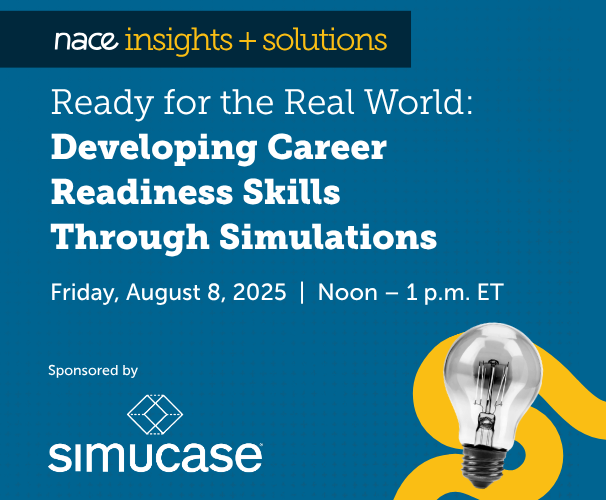NACE Journal / May 2022
Career Readiness Resources
NACE maintains a repository through which members can share their career readiness resources.New to the repository is “Curated Resources for Teaching and Assessing Career Readiness Competencies,” a compendium developed through a grassroots effort by NACE members. Access this and other resources at www.naceweb.org/career-readiness/resources/ .
Interested in sharing your resources? You can do so through the NACE website at www.naceweb.org/career-readiness/competencies/share-your-career-readiness-resources/.
In March, NACE hosted the Competency Symposium, bringing together more than 850 practitioners to gain insights, strategies, and tactics for developing career-ready students and graduates. The event, held virtually, featured nearly 20 sessions. This article highlights key ideas from a few of those sessions.
1. Words matter.
Having a model that works for the campus is, in the long run, more efficient and effective than siloed approaches. Ultimately, that means bringing a career readiness lens to everything—from on-campus student employment opportunities to external internships to classroom assignments.
That’s not possible, however, without first establishing a common language to discuss and describe what the student is developing—competencies. As Patrick Madsen, University of North Carolina at Charlotte, pointed out in his session, the more people who use “competencies” instead of “soft skills,” the better.
Getting everyone on the same page language-wise doesn’t just support philosophical underpinnings of career readiness; it has practical applications as well. For example, on-campus jobs could be tagged by competency, helping the student readily understand what they will develop through the experience.
A common language is also integral to collaboration—among career services, faculty, and even industry.
2. Faculty play a significant role in helping students understand and develop career readiness competencies.
Research shows that students often turn to faculty for job-search advice. In fact, nearly 60% of graduating seniors responding to the 2021 NACE Student Survey reported that they turned to faculty for help. But there is a disconnect; only 30% of those students said faculty were helpful in the job search. Generally speaking, this may be because faculty typically are not well versed in the types of jobs their students can get or what specific companies look for in job candidates. Regardless, getting faculty to understand the impact they can have is important: Career services can make the case by pointing to the research. In the Symposium’s closing session, student panelists consistently referred to faculty and classroom experiences as important to their ability to develop competencies and called for greater collaboration between faculty and career services.
3. Faculty do NOT have to change what they do.
One of the biggest barriers to engaging faculty in career readiness is misunderstanding surrounding the nature of that involvement.
Madsen believes the underlying issue is that “the competencies get lost in translation”—not that students aren’t developing those competencies through their academics.
Angela Christie, Georgia State University, agrees. “Every single competency exists in the class,” she says. Faculty need help connecting what they do to the competencies.
Faculty are already helping students build career readiness competencies. They do not have to change what they are teaching or doing. They simply have to explain to students how the class and its assignments and activities apply.
That’s where career services can bring its expertise to bear.
4. Career services serves as the translator.
From the Competency Symposium
Free webinar: NACE hosted a free webinar on March 3 to kick off the Symposium. The one-hour webinar, “Competency Initiatives: Shaping the Future of Student Success and Institutional Effectiveness,” can be accessed at www.naceweb.org/competency-symposium/index.html#kick-off.Career services’ expertise is not in designing courses but in helping faculty explain how those courses relate to competency development.
“We’re not asking faculty to upend their course,” explains Madsen, “We’re just asking them to tell students what [the students] are doing in terms of competency development through the course.”
To facilitate that translation, Madsen provides faculty training. This includes working with faculty to update the course description and syllabus with competency language. Training goes beyond that initial step and includes articulating competency development in assignments—helping to demonstrate to students the connection between the assignment and, down the line, work, and more. The approach does not alter the course content—rather it explains it in terms of competency development and infuses intentionality into that development.
5. Career services should support faculty efforts in meaningful ways and provide essential tools.
At Georgia State University, the “College to Career” effort provides faculty with a tool to help with the translation; faculty use it to connect competencies to assignments. Faculty access the tool through a Learning Management System.
Toolkits, which include homework assignments among other materials, as well as grants and fellowships for faculty to develop “College to Career” curriculum are additional means of providing support and gaining faculty buy-in.
Good Practice According to Students
Engage early—the sooner the better: A first-year course that supports the transition to college and introduces campus services and resources, including career services as well as the idea of career readiness, will help students get involved and on the right path early. Ideally, this should be a required course that all students must take.Meet students where they are: There is a lot competing for students’ attention, so raising awareness is key. Moreover, the career center’s physical location can be a problem if it’s not readily visible to students or is not in proximity to other student centers. If students aren’t visiting the career center, think about how to bring it to them. Obviously, getting into the classroom in front of students is ideal for introducing students to career readiness as well as the services provided by the career center, but it can be as simple as setting up a table in a high-traffic area to provide accessibility and raise awareness. Providing an array of online resources is also a means for addressing accessibility issues, assuming students are aware of the virtual options. In particular, student panelists identified online resources that students can look through on their own as important for reaching reluctant students.
Partner with faculty: Students recognize the connection between classroom and career and look for career services and faculty to collaborate to help them with that connection. Having career services come into the classroom to present information is helpful, but meaningful partnership goes deeper.
Tailor communications: Competency development is highly individualized, and communications advocating for competency development need to reflect that. Providing a variety of ways for students to take part in competency development in personalized ways is important.
References
Career Readiness in the Academic Space: Integrating Career Services and Curriculum Development. Faculty and Academic Leadership: Session 1. NACE 2022 Competency Symposium, March 29, 2022. Presented by Angela Christie, Ph.D., Georgia State University.
How “Career Ready Are Students? National Findings From the Career Readiness Project & Innovative Practices at ASU & Purdue. NACE 2022 Competency Symposium, March 29, 2022. Panel: Randy Bitting, SkillSurvey; Sarah Ratekin, Purdue University; Scott Travis, Arizona State University. Moderator: Matthew Brink, NACE.
My Competency Journey: Student Panel. NACE 2022 Competency Symposium, March 29, 2022. Panel: Joey Adamle, University of Minnesota – Twin Cities; William Arnold, University of Tampa; Ellen Hollins, Hendrix College; Ashley Persson, Clemson University; Bibi Khemraj, LaGuardia Community College. Moderator: Nicole Hall, University of North Carolina at Greensboro.
Re-Imagining Career Competency Integration. Faculty and Academic Leadership: Session 2. NACE 2022 Competency Symposium, March 29, 2022. Presented by Patrick Madsen, University of North Carolina at Charlotte.







